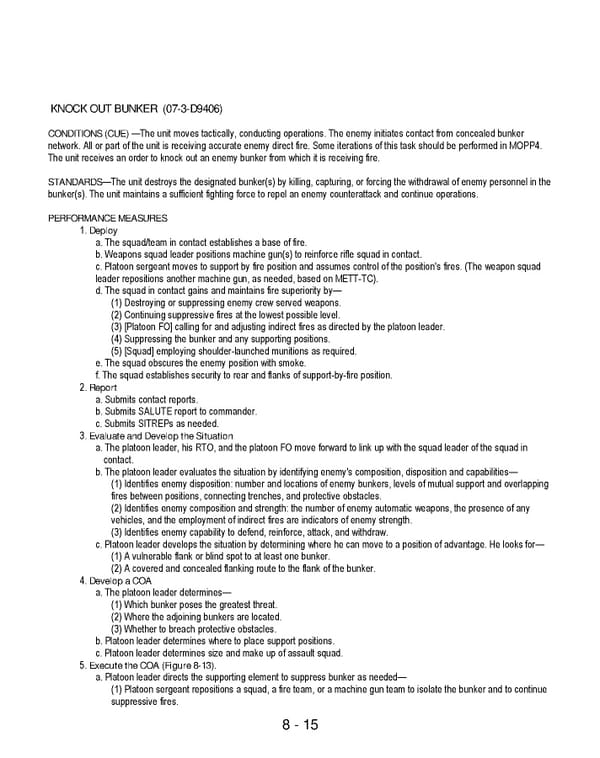8 - 15 KNOCK OUT BUNKER (07-3-D9406) CONDITIONS (CUE) —The unit moves tactically, conducting operations. The enemy initiates contact from concealed bunker network. All or part of the unit is receiving accurate enemy direct fire. Some iterations of this task should be performed in MOPP4. The unit receives an order to knock out an enemy bunker from which it is receiving fire. STANDARDS—The unit destroys the designated bunker(s) by killing, capturing, or forcing the withdrawal of enemy personnel in the bunker(s). The unit maintains a sufficient fighting force to repel an enemy counterattack and continue operations. PERFORMANCE MEASURES 1. Deploy a. The squad/team in contact establishes a base of fire. b. Weapons squad leader positions machine gun(s) to reinforce rifle squad in contact. c. Platoon sergeant moves to support by fire position and assumes control of the position's fires. (The weapon squad leader repositions another machine gun, as needed, based on METT-TC). d. The squad in contact gains and maintains fire superiority by— (1) Destroying or suppressing enemy crew served weapons. (2) Continuing suppressive fires at the lowest possible level. (3) [Platoon FO] calling for and adjusting indirect fires as directed by the platoon leader. (4) Suppressing the bunker and any supporting positions. (5) [Squad] employing shoulder-launched munitions as required. e. The squad obscures the enemy position with smoke. f. The squad establishes security to rear and flanks of support-by-fire position. 2. Report a. Submits contact reports. b. Submits SALUTE report to commander. c. Submits SITREPs as needed. 3. Evaluate and Develop the Situation a. The platoon leader, his RTO, and the platoon FO move forward to link up with the squad leader of the squad in contact. b. The platoon leader evaluates the situation by identifying enemy's composition, disposition and capabilities— (1) Identifies enemy disposition: number and locations of enemy bunkers, levels of mutual support and overlapping fires between positions, connecting trenches, and protective obstacles. (2) Identifies enemy composition and strength: the number of enemy automatic weapons, the presence of any vehicles, and the employment of indirect fires are indicators of enemy strength. (3) Identifies enemy capability to defend, reinforce, attack, and withdraw. c. Platoon leader develops the situation by determining where he can move to a position of advantage. He looks for— (1) A vulnerable flank or blind spot to at least one bunker. (2) A covered and concealed flanking route to the flank of the bunker. 4. Develop a COA a. The platoon leader determines— (1) Which bunker poses the greatest threat. (2) Where the adjoining bunkers are located. (3) Whether to breach protective obstacles. b. Platoon leader determines where to place support positions. c. Platoon leader determines size and make up of assault squad. 5. Execute the COA (Figure 8-13). a. Platoon leader directs the supporting element to suppress bunker as needed— (1) Platoon sergeant repositions a squad, a fire team, or a machine gun team to isolate the bunker and to continue suppressive fires.
 Ranger Handbook Page 152 Page 154
Ranger Handbook Page 152 Page 154